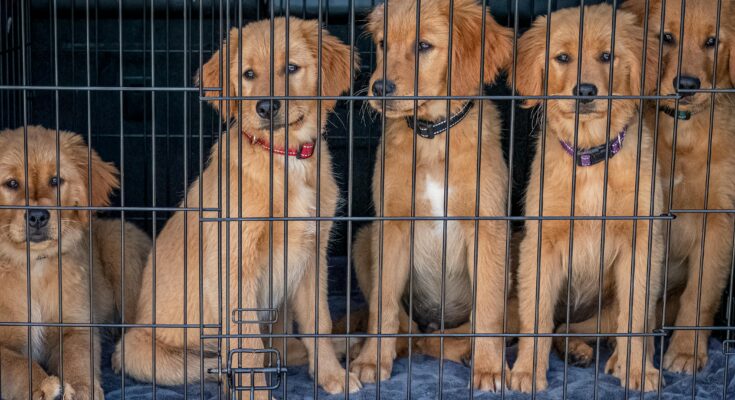Introduction: A Community’s Wake-Up Call
In 2011, a call about suspected animal hoarding in Slidell, Mississippi, led authorities to a shocking discovery: 175 dogs rescue from hoarders in slidell mississippi 2011 kept in cramped, filthy conditions, neglected and in urgent need of care. The sight was unimaginable—dozens of dogs, some sick, others injured, all struggling to survive in what had become a nightmarish environment. This incident ignited a large-scale rescue effort that highlighted the need for stronger animal welfare laws and spurred a movement of compassion within the community.
Behind the Doors of 175 dogs rescue from hoarders in slidell mississippi 2011
Hoarding is an illness that affects not only the hoarder but also any living beings within their care.In this case, the hoarder accumulated over 175 dogs, and many of these dogs suffered from malnutrition, untreated medical conditions, and behavioral issues because of neglect.
- Unsanitary living: The conditions surrounding the dogs included areas filled with waste, limited food, and contaminated water.
- Overcrowding and Health Hazards: Living in such close quarters increased the spread of disease, and many dogs exhibited signs of respiratory infections and skin conditions.
Key Steps in the Rescue Mission
Animal welfare organizations, local shelters, and volunteers came together to rescue the dogs. Below is a breakdown of the complex and compassionate efforts that took place:
- Initial Assessment and Planning
Animal control officers and veterinarians conducted an initial assessment to determine the health and severity of each dog’s condition.
Veterinary clinics prioritized dogs with urgent medical needs, transferring them immediately for treatment.
- Transport and Temporary Shelter
Due to the high number of animals, rescuers coordinated transport with the help of multiple animal rescue organizations, using animal transport vans to safely relocate the dogs to temporary shelters.
A local facility was transformed into a makeshift shelter, equipped to handle the large influx of dogs with food, clean water, and bedding.
- Medical Intervention and Rehabilitation
Each dog underwent a thorough medical examination, including vaccinations, deworming, and treatment for skin infections and respiratory illnesses.
Emotional care was crucial. Experienced handlers and animal behaviorists paired with dogs showing signs of trauma and worked patiently to reduce their anxiety and help them trust humans again.
Challenges Faced by Rescuers
Rescuing such a large number of dogs came with a set of unique challenges:
- Resource Allocation: The sheer scale of the rescue meant that resources, including medical supplies and food, were stretched thin.
- Emotional Trauma: Many dogs displayed behavioral issues, such as fear aggression or extreme anxiety, which required specialized care to overcome.
- Community Coordination:The local community played an instrumental role by contributing donations, volunteering time, and assisting in the placement of animals after rehabilitation.
Emotional and Physical Rehabilitation for the Dogs
The journey to recovery for these dogs was just beginning. Behavioral experts and veterinary teams collaborated to help these dogs heal, both physically and emotionally. Local community members actively contributed donations, volunteered their time, and assisted in placing the animals after rehabilitation.
- Medical Recovery:The team put dogs suffering from malnutrition, dehydration, or disease on balanced diets and provided them with regular veterinary care.
- Socialization Programs: Some dogs had lived in isolation for so long that they needed gentle reintroduction to people. Animal behaviorists used techniques like gradual desensitization and positive reinforcement.
- Adoption Readiness: As each dog progressed, the team evaluated its readiness for adoption, with some requiring longer-term foster homes for continued care.
The Community’s Role: Coming Together to Support the Dogs
The Slidell community played an essential role in this effort. Residents contributed by:vb
- Donating Supplies: Local businesses and citizens donated food, bedding, toys, and cleaning supplies.
- Volunteer Work: Community members volunteered their time, helping with daily care routines, feeding, and playing with the dogs to aid in their socialization.
- Adoption Efforts: The community helped spread the word about adoption events, and many families stepped up to give these dogs a forever home.
Legal and Policy Impacts: Raising Awareness and Advocating for Change
This rescue sparked conversations about the importance of animal welfare laws in Mississippi and beyond. Key outcomes included:
- Stricter Animal Hoarding Regulations: Awareness of the situation led to calls for stricter regulations on the number of animals one person can own without adequate facilities.
- Funding for Animal Welfare: The event underscored the need for consistent funding and resources for animal rescue organizations.
- Increased Public Awareness: This case raised public awareness about the warning signs of hoarding, helping the community understand the importance of early intervention.
Success Stories: A Second Chance at Life
Many of the rescued dogs eventually found their forever homes, providing heartwarming stories of resilience and recovery:
- Stories of Transformation: Dogs who were once fearful and mistrustful grew into loving companions. Adopters observed that these dogs displayed special affection, as if they recognized the second chance they had received.
- Community Updates: Some adopters kept in touch with the rescue organizations, sharing photos and updates on the dogs’ new lives.
How to Help in Cases of Animal Hoarding
Animal hoarding is more common than one might think. Here’s what you can do if you suspect someone is hoarding animals:
- Report Concerns to Animal Control: Early intervention can prevent severe cases of neglect.
- Support Local Shelters: Donations and volunteer efforts strengthen animal rescues, making it possible for them to respond to large-scale rescues.
- Advocate for Stronger Laws: Community advocacy can push for improved welfare laws that protect animals and provide necessary support for rescue efforts.
Conclusion:
The 175 dog rescue in Slidell, Mississippi, in 2011 remains a testament to the power of community, compassion, and resilience. These dogs, who started in one of the darkest places, received a second chance through the dedication of volunteers, veterinarians, and families.Their story reminds us that every life is precious and worth saving and that, together, communities can make a significant difference.
FAQs
What led to the rescue of the 175 dogs in Slidell?
Local authorities received reports of a suspected hoarding situation, leading to an investigation and the eventual rescue.
What conditions were the dogs found in?
The dogs were in overcrowded, unsanitary spaces with limited access to food, clean water, and medical care.
How did rescuers handle such a large number of dogs?
They coordinated with multiple animal welfare organizations, created temporary shelters, and prioritized medical care for the most urgent cases.
Were all the dogs eventually adopted?
Most were adopted, while some required long-term foster care due to medical or behavioral challenges.
What legal changes resulted from this case?
The case raised awareness and encouraged advocacy for stricter animal hoarding regulations and improved animal welfare laws.
How can I help if I suspect animal hoarding in my community?
Report any suspicions to local animal control, support animal rescue groups, and consider donating to or volunteering with shelters.
What are the warning signs of animal hoarding?
Indicators include large numbers of animals kept in confined or unsanitary conditions, signs of neglect, and owners unable to provide adequate care.
How did this case impact the Slidell community?
The community rallied together, providing donations, volunteering, and supporting adoption efforts, demonstrating the power of collective compassion.




